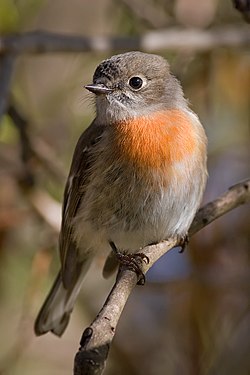| Scarlet robin | |
|---|---|
 | |
| Male | |
 | |
| Female | |
| Scientific classification | |
| Kingdom: | Animalia |
| Phylum: | Chordata |
| Class: | Aves |
| Order: | Passeriformes |
| Family: | Petroicidae |
| Genus: | Petroica |
| Species: | P. boodang |
| Binomial name | |
| Petroica boodang (Lesson, RP, 1837) | |
 | |
| Distribution map | |
| Synonyms [2] | |
Petroica multicolor boodang | |

The scarlet robin (Petroica boodang) is a common red-breasted Australasian robin in the passerine bird genus Petroica . The species is found on continental Australia and its offshore islands, including Tasmania. The species was originally split in 1999 by Schodde and Mason, [3] and as the original collection by Gmelin was from Norfolk Island, this retained the name of multicolor, and is now known as the Norfolk robin.




